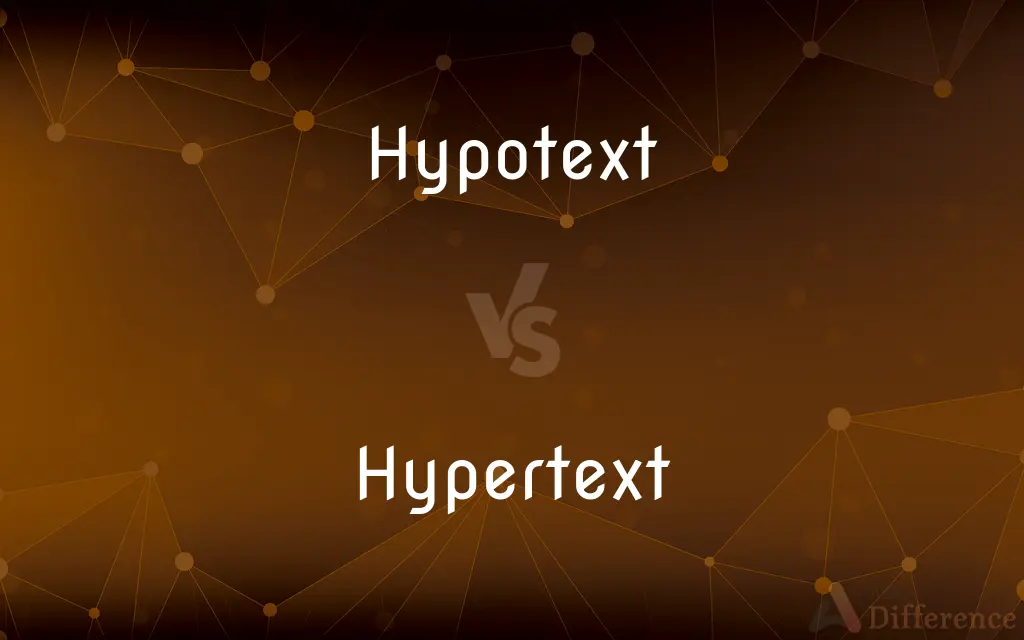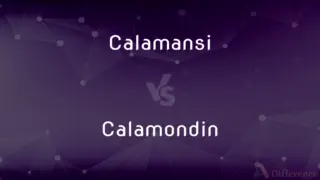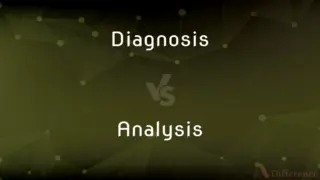Hypotext vs. Hypertext — What's the Difference?
By Maham Liaqat & Urooj Arif — Updated on April 7, 2024
Hypotext refers to a text that serves as the source or basis for another work, whereas hypertext is a digital text system allowing for non-linear navigation through links.

Difference Between Hypotext and Hypertext
Table of Contents
ADVERTISEMENT
Key Differences
Hypotext is a literary term that identifies a text serving as a foundation or source for another text, known as a hypertext in literary studies. This relationship involves adaptation, allusion, or direct quotation, where the newer work (hypertext in the literary sense) draws upon the content, style, or thematic elements of the hypotext. In contrast, in digital and web contexts, hypertext refers to a system of managing digital texts where individual items of text (words, phrases, or documents) are linked to other texts, allowing users to navigate from one text to another non-linearly, often through clickable links.
The concept of hypotext is central to intertextuality, highlighting how texts influence each other across time. This influence can manifest through various forms such as parody, pastiche, or homage. On the other hand, hypertext embodies the technological advancement in text management and presentation, epitomized by the World Wide Web, where documents are interconnected through hyperlinks, facilitating an interactive and integrated information space.
While hypotext operates within the realm of literary analysis and criticism, focusing on the relationships between texts and their cultural, historical, or thematic contexts, hypertext is inherently technological, emphasizing the structure and accessibility of information over the internet. This distinction underscores the different applications and implications of the terms, with hypotext engaging with the content and meaning of texts, and hypertext with the format and dissemination of digital information.
Hypotextual relationships are explored to understand the depth of literary works, examining how older texts contribute to the meaning and interpretation of newer ones. Conversely, hypertextual structures are utilized to enhance the usability and navigability of information, transforming the way people access and engage with content online. The contrast between the static, historical connections of hypotext and the dynamic, user-driven navigation of hypertext reflects the evolution of text as a medium from print to digital.
While both hypotext and hypertext concern the relationship between texts, their focuses diverge significantly: hypotext is concerned with the influence and transformation of literary works over time, whereas hypertext deals with the practical aspects of linking digital content to facilitate easier access and exploration by users. This distinction not only highlights the different academic and technological contexts in which the terms are used but also reflects the broader shift in how text is conceived and interacted with in the digital age.
ADVERTISEMENT
Comparison Chart
Definition
A foundational text that influences another work
A digital text system with non-linear navigation through links
Context
Literary studies, intertextuality
Digital technology, web content
Function
Serves as a source or inspiration for other texts
Enables interconnected, non-linear access to information
Usage
Analyzing literary influences and adaptations
Navigating and accessing digital information efficiently
Examples
Homer's Odyssey as a hypotext for James Joyce's Ulysses
Websites, digital documents with clickable links
Compare with Definitions
Hypotext
A foundational text influencing later works.
Virgil's Aeneid is a hypotext for Dante Alighieri's Divine Comedy.
Hypertext
Technology enabling the integration of text with other media.
E-books often include hypertext links to definitions, annotations, or related media.
Hypotext
Original source material for adaptations.
Shakespeare's plays often serve as hypotexts for modern movies and novels.
Hypertext
A format for organizing information in a multi-dimensional space.
Digital libraries catalog their collections using hypertext to facilitate research.
Hypotext
A text that underlies thematic or narrative elements in another.
Greek mythology acts as a hypotext for much of Western literature.
Hypertext
The basis of web design, allowing for dynamic user experiences.
News websites use hypertext to connect articles, sources, and multimedia.
Hypotext
Root text from which derivative works are inspired.
Beowulf is a hypotext for J.R.R. Tolkien's Middle-earth legendarium.
Hypertext
Digital text connected through links for non-linear navigation.
Wikipedia articles are examples of hypertext, enabling users to jump between related topics.
Hypotext
The basis for intertextual references and allusions.
The Iliad is a hypotext for countless poems and stories exploring heroism and conflict.
Hypertext
Web content that users interact with through clickable links.
Online educational platforms use hypertext to structure courses and resources.
Hypotext
Hypotext is an earlier text which serves as the source of a subsequent piece of literature, or hypertext. For example, Homer's Odyssey could be regarded as the hypotext for James Joyce's Ulysses.
Hypertext
Hypertext is text displayed on a computer display or other electronic devices with references (hyperlinks) to other text that the reader can immediately access. Hypertext documents are interconnected by hyperlinks, which are typically activated by a mouse click, keypress set, or screen touch.
Hypotext
(semiotics) An earlier text which serves as the source of a subsequent piece of literature.
Hypertext
Digital text that contains hyperlinks to other texts.
Hypertext
(uncountable) Digital text in which the reader may navigate related information through embedded hyperlinks.
Hypertext
(countable) A hypertext document.
Hypertext
Machine-readable text that is not sequential but is organized so that related items of information are connected;
Let me introduce the word hypertext to mean a body of written or pictorial material interconnected in such a complex way that it could not conveniently be presented or represented on paper
Common Curiosities
How does hypertext work?
Hypertext works by linking text elements (words, phrases) to other documents or sections within a document, allowing users to navigate information in a non-linear manner.
What is an example of a hypotext?
Homer’s Odyssey is a hypotext for James Joyce’s Ulysses, where the latter draws extensively from the themes, structure, and characters of the former.
Can a text be both hypotext and hypertext?
Yes, a text can be both, depending on the context. For example, a novel that references classical literature is a hypertext to those works (hypotexts) but can itself be a hypotext if later works reference it.
Why is hypertext important?
Hypertext is important because it revolutionized information access and consumption on the internet, making it easier to navigate and interconnect vast amounts of content.
How does hypotext contribute to understanding literature?
Hypotext helps in understanding literature by revealing how texts are interconnected, influenced by, and respond to earlier works, enriching the interpretation of themes and motifs.
What technologies use hypertext?
Web browsers, digital encyclopedias, and online educational resources extensively use hypertext to facilitate information retrieval and learning.
How do authors use hypotext?
Authors use hypotext by incorporating or responding to themes, styles, or content from earlier works, adding layers of meaning to their texts.
What role does hypertext play in web design?
In web design, hypertext is crucial for creating user-friendly, navigable websites that allow visitors to move easily between related pages and topics.
Is hypertext limited to text?
While hypertext primarily involves text, it can also include links to other media types like images, videos, and sound, enhancing multimedia interaction.
How does hypotext affect the originality of a work?
While some might argue that reliance on hypotext could compromise originality, others see it as a rich tradition of dialogue between texts, enhancing depth and complexity.
Can hypertext improve learning?
Yes, hypertext can improve learning by providing learners with flexible paths to explore subjects according to their interests and needs, fostering a more engaging and interactive educational experience.
Are there criticisms of hypertext?
Critics of hypertext point to potential drawbacks like information overload, decreased linear reading skills, and the challenge of maintaining coherent narratives in non-linear formats.
Share Your Discovery

Previous Comparison
Calamansi vs. Calamondin
Next Comparison
Diagnosis vs. AnalysisAuthor Spotlight
Written by
Maham LiaqatCo-written by
Urooj ArifUrooj is a skilled content writer at Ask Difference, known for her exceptional ability to simplify complex topics into engaging and informative content. With a passion for research and a flair for clear, concise writing, she consistently delivers articles that resonate with our diverse audience.
















































